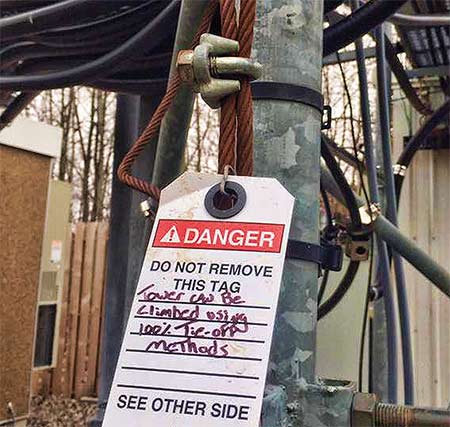
Scott Kisting, Chairman of the Board of Directors of TIRAP, discusses some of the serious issues with safety climbs on existing structures. Joey Deuer (inset) was elected chairperson of the new working group.
Officials from the Telecommunications Industry Registered Apprenticeship Program (TIRAP), which aims to promote worker safety, quality and efficiency within the wireless infrastructure industry, gathered representatives from wireless carriers, tower companies and safety climb system equipment manufacturers to hold a Safety Equipment Manufacturers Summit to maximize the critical role safety climb equipment plays in protecting climbers.
The purpose of the gathering was to help ensure safety climb systems are installed, maintained and inspected properly and in accordance with existing standards.
For many years, the industry has been aware of failing systems, incompatibility of components, misuse and other concerns that endanger the lives of the nation’s 29,000 tower technicians that climb towers and rely upon flexible cable type safety systems.
Last Thursday, a Washington technician was seriously injured in Texas when he was ripped off a structure when a climbing cable came loose from its anchorage. Although that incident wasn’t discussed formally at the summit, it was talked about during lunch and breaks, according to two individuals attending the work group meeting.
Joining TIRAP at the Summit were officials from PCIA – The Wireless Infrastructure Association (PCIA), the Telecommunications Industry Association (TIA), the National Wireless Safety Alliance (NWSA), the National Association of Tower Erectors (NATE), and the U.S. Occupational Safety and Health Administration (OSHA). SBA Communications Corporation hosted the event in their Alpharetta, Ga. facility.
The primary accomplishment of the meeting was the establishment of a formal working group to create specific industry standards as well as a common vocabulary for safety climb systems used in the installation, maintenance and inspection of safety climb systems.
The group also will work to clarify the requirements necessary for competent contractors to properly inspect safety climb systems prior to considering their use as part of the fall protection plan for the scope of work on a telecommunications site, as well as the inspection of this equipment as an appurtenance on the structures.
Joey Deuer, President of Tuf-Tug, an Ohio-based safety equipment engineering and manufacturing firm, was elected Chairperson of the Working Group.
“As the wireless infrastructure industry matures, we have reached a pivotal moment as we all seek to increase commitments to safety and quality,” said Scott Kisting, Senior Vice President at SABRE/MUTI Tower Service Co. and Chair of the TIRAP Board of Directors.
“This Summit addressed these issues as we continue our work to develop consistency across manufacturers of safety climb systems, and we are very excited that Mr. Jeremy Buckles from SBA has worked to assemble this group and convey the concerns to the industry,” said Kisting.
A number of topics and objectives under discussion at the summit were:
- Creating written installation guidelines for all flexible cable type systems
- Creating written maintenance guidelines for all flexible cable type systems
- Confirming the fact that per TIA guidelines, once a flexible cable type system is installed on the structure it becomes an appurtenance of that structure
- Creating written inspection guidelines for competent contractors to use for all flexible cable type systems prior to climbing or use as PPE
- Identifying the loads applied to the structure by the system
- Agreeing upon a common system capacity rating in pounds
- Creating common labeling to be located at the base connection of the systems. It must include the number of users the system is designed to support, the manufacturers ID and serial # and any unique inspection requirements for the system
- Assuring all components such as the cable grab are compatible with each other’s systems
- Agreeing upon a common 3/8” cable type. There was discussion of 6/19 316 marine grade stainless steel IWRC cable



















